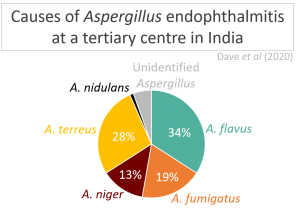Submitted by Aspergillus Administrator on 21 June 2012
Aspergillus infections of the eye are widespread and are relatively common in parts of the world that still commonly use labour intensive agricultural methods e.g. India. In such rural areas there is quite a high risk of people getting irritating foreign bodies into their eyes – commonly grain husks or damage caused by swipes of a cows tail.
The immune system of the eye is slightly different to that of the rest of the human body. Immune privilege and lack of some inflammatory response enables the eye to carry on functioning if injured, but can also mean that if one eye is injured, both eyes can be lost. For these reasons infections of the eye warrant specialist consideration.
 |
| Red stained Aspergillus infecting the eye |
This paper used an experimental model to study Aspergillus infection of the eye in which the fungus has been genetically altered to glow red. This enables it to be easily observed when infecting an eye. This group demonstrate here that neutrophils and their ability to produce reactive oxygen are important for the prevention of infection of our eyes by Aspergillus.
The fungus is known to be able to respond to neutrophil attack by producing their own anti-oxidation chemicals. An important part of the metabolic pathways used by the fungus to produce anti-oxidation chemicals is the gene product Yap-1 so the importance of this gene product was tested in this study and it was found to be important for the establishment of infection of the eye.
As a result of this work we now have new clear targets for the development of new drugs to treat Aspergillus infection of the eye so perhaps there is hope that blindness caused by these infections (often following injury) will effect far fewer people at some point in the future.
News archives
-
Title
Date


